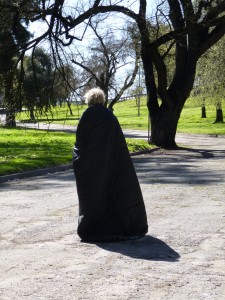
As a rule, homeless people fall into three or four broad categories. The three most common, “vagrants, transients, and addicts” are pejorative terms based on the notion that “these people” have brought their troubles on themselves. A fourth category suggests homeless people are “victims” of cruel society that has abandoned its most vulnerable members.
All these ways of looking at homelessness contain grains of truth, but none really does much more than produce an oversimplified way of thinking not much different from racism or sexism. All tend to reduce homelessness to broad categories that make it too easy to ignore the stark realities of people in need.
Consider that most people familiar with homelessness estimate that twenty-five to forty percent of homeless people are mentally ill. That’s a staggering figure and a makes the “victim” category seem inadequate.
Consider also that now that there’s a nationwide heroin epidemic, addiction isn’t being viewed so much as a moral failing as it is as a health problem involving both mental and physical well-being.
Both Jeb Bush and Carly Fiorina have experienced drug abuse with close family members and neither views punishment as the cure for addiction. Fiorina said recently that, “If you’re criminalizing drug abuse and addiction, you’re not treating it—and you’re part of the problem.”
If we factor in the percentage of homeless people who are mentally ill with the percentage who are addicted to drugs, we have an overwhelming majority already. Add those whose jobs went to China or were eliminated by automation, computing, and artificial intelligence, and we’ve accounted for almost the entire homeless population.
Yes, some homeless people are opportunistic, shiftless, predatory criminals, as unwelcome by homeless people as they are by anyone else. Most of the crimes they commit are petty and low, most especially those against the homeless.
But given what we know about homelessness, it makes virtually no sense to try to eliminate it with pejorative labels like “vagrant” and “addict,” “move-on” ordinances, and closed restrooms in public places. Telling people with nowhere to go and no way of getting there to “move on” is like telling people with measles to move on—all you do is spread the problem around and make it harder to deal with.
According to a recent United Way study, one-third of California families struggle week-to-week to make ends meet. In Stanislaus County, the figure rises to thirty-six percent. Given those figures, homelessness is less a personal failing than it is the ugly bare parts of poverty showing through a torn social fabric.
What kind of society tells mentally and physically ill people to “move along” down the unforgiving lanes of poverty and despair? How do people who boast of a “Christian nation” justify turning away from people in need?
Faced with the material and moral problems brought on by short-sighted social reforms and economic decisions that eroded our middle class, our only options so far have been useless labels and failed policies. To paraphrase Carly Fiorina, we’re not treating the problem, we’re part of the problem.
